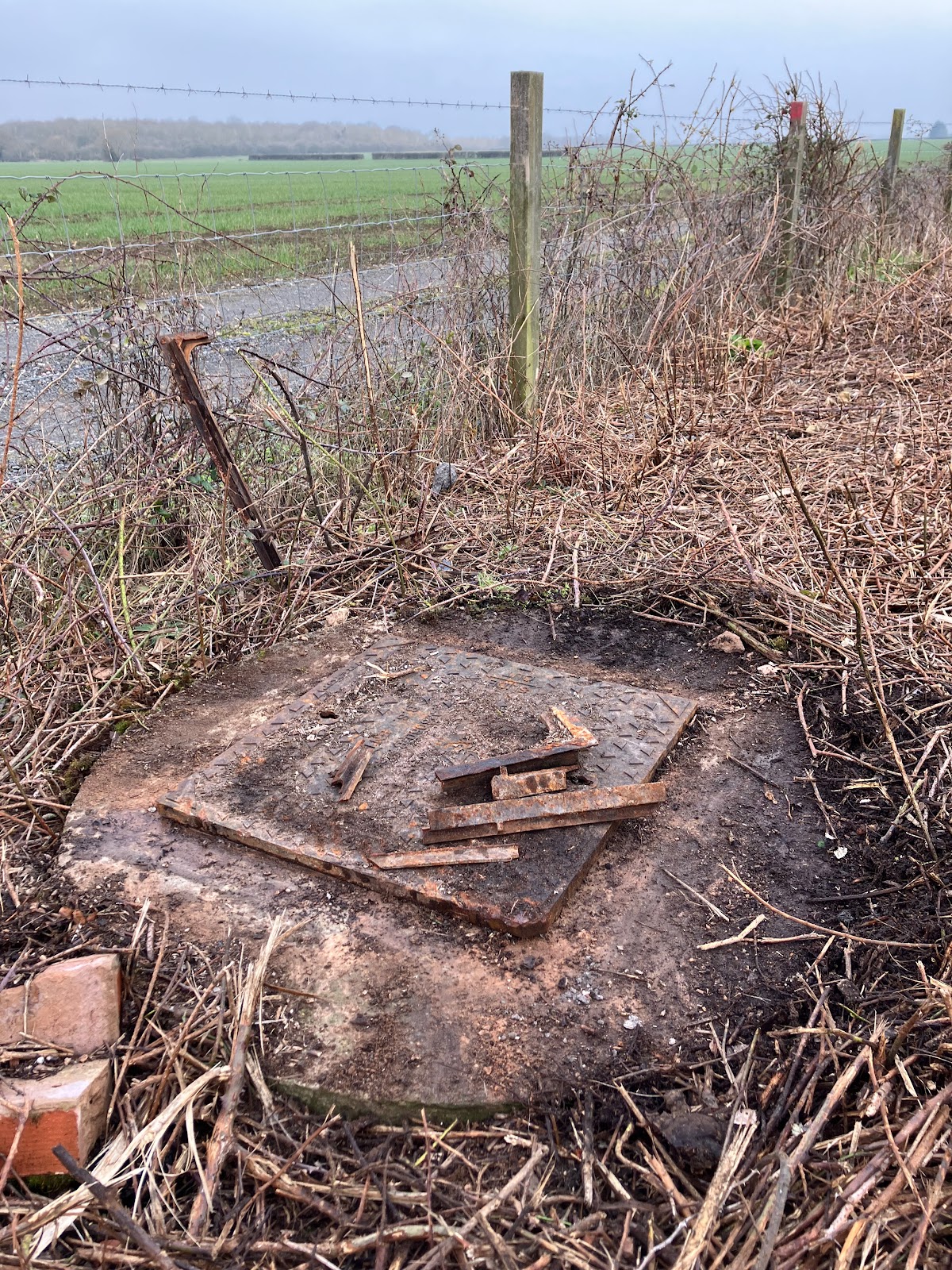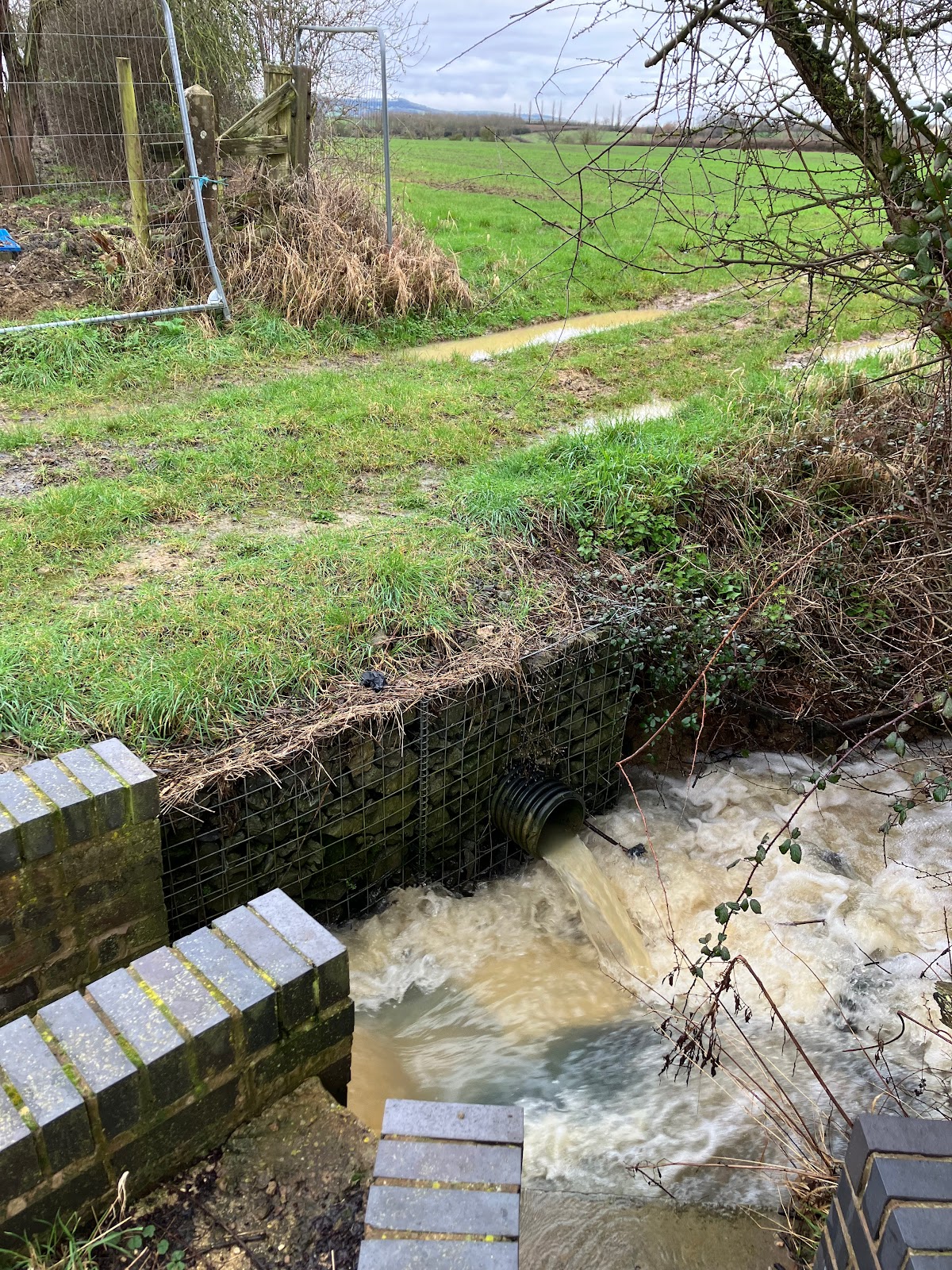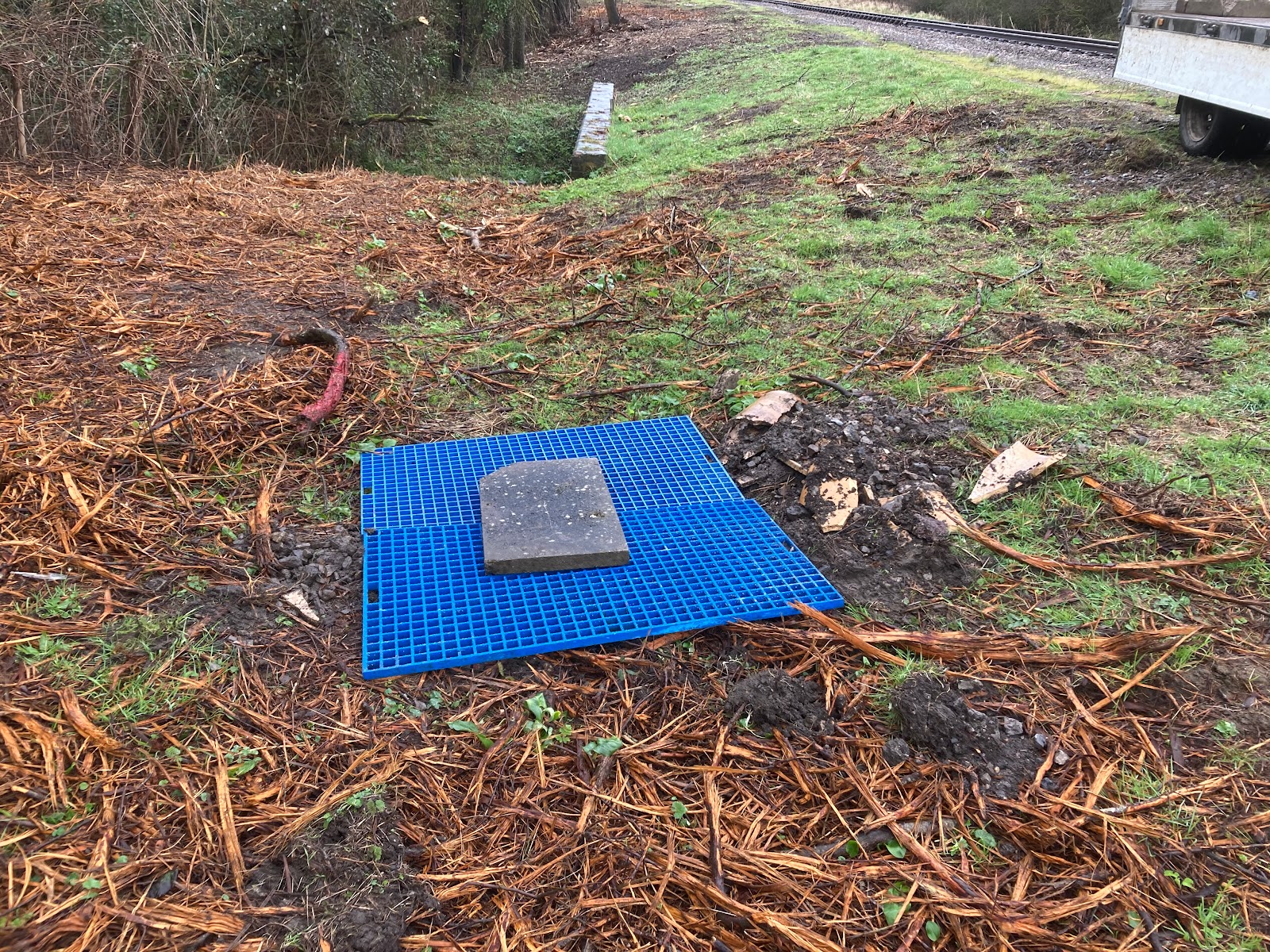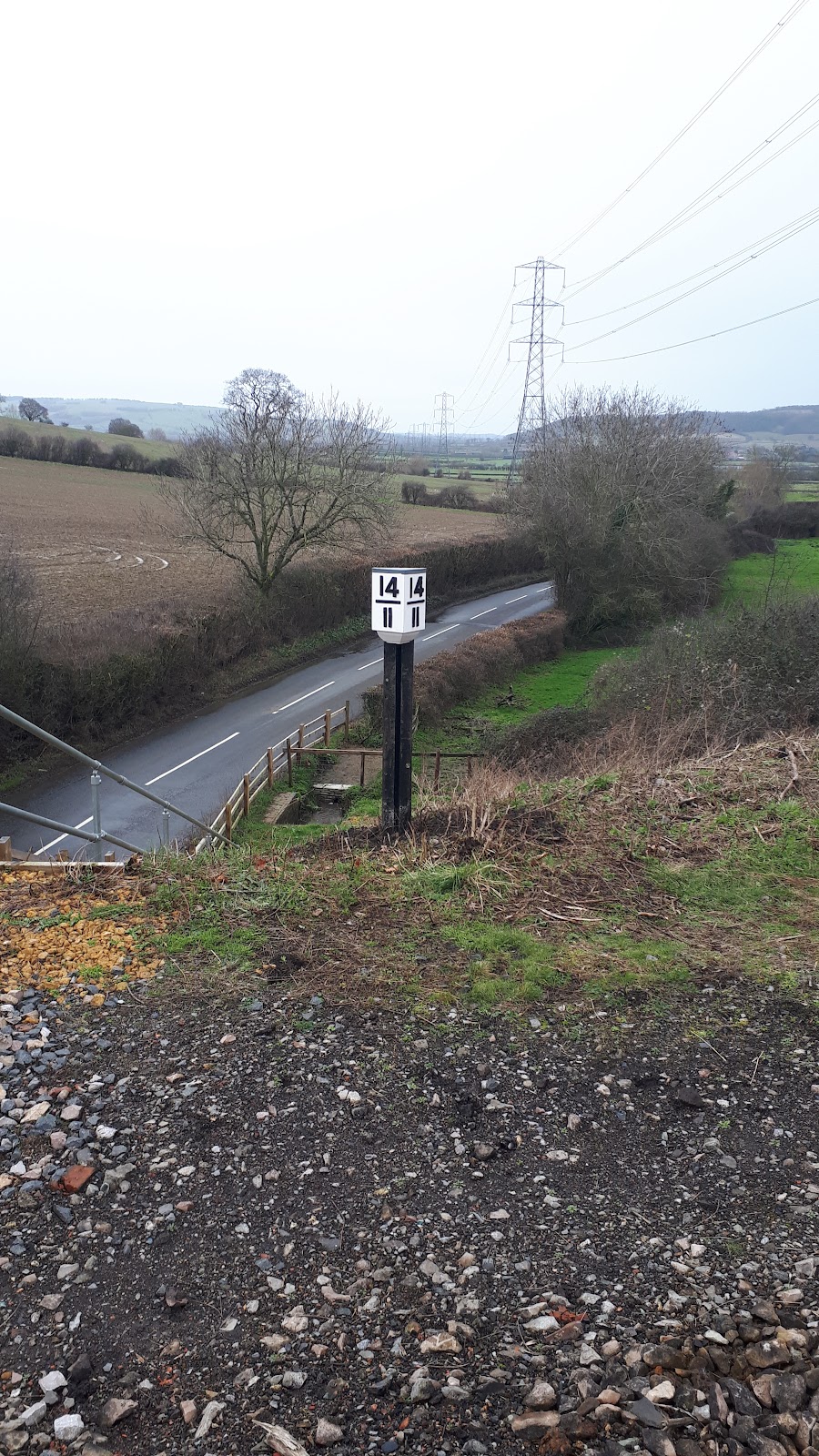Thursday 7th March
Five of the team attending today with various jobs on the list to complete.
First unblock the grills under Meadow Lane bridge at Laverton. Unfortunately, the water levels had not dropped much from last week and were still at the 2 foot flood level. Despite two team members attempting to reach them the water levels were well above Wellington depth so item left for another week. To complicate issues a different car sat unoccupied in the water.
 |
| Meadow Lane - still to deep for Wellingtons, and normal cars! [Photo by Dave] |
Second on the list was servicing some of our equipment. Completed today was cleaning and greasing the digger; servicing the generator and one of the concrete mixers. Spark plug change on the mixer outstanding due to lack of correct plug socket.
Next on the list was a report from track inspections of a broken manhole on the upside toe drain, low mileage side of bridge 6 from the robot flail. Yes the flail had gone through a course of bricks and the steel manhole ring sitting on top of the concrete biscuits. We inspected the four other manholes in this toe drain. A further one had substantial flail damage to brickwork; one was intact and two had suffered frost damage with complete mortar failure. So four structures in need of immediate repair.
 |
| First up side toe ditch chamber requiring attention. [Photo by Dave] |
 |
| And the second one. [Photo by Dave] |
 |
| Third one - brick course repaired. [Photo by Dave] |
 |
| Fourth one - repair to be completed next week. [Photo by Dave] |
We manage to rebuilt or repair three today; the fourth one awaits rebuild next week. Fortunately we had in stock one manhole ring and cover.
Also on the list today was the rebuilding of the low mileage up side wing wall of the River Isbourne bridge. However, we had to postpone this, not due to weather this time but because the work at Laverton had taken more time than anticipated.
(Todays report from Roger, as the team leader was away attending a funeral.)
Thursday 14th March
Six team members in attendance - some battling through Cheltenham racing traffic and lorry fires on the M5 to get in.
A group of four headed to Laverton to complete the repairs to up side toe drain chambers which had been damaged by the robo flail. This is length where an embankment slip was repaired as part of the reopening to Broadway. The other task at this location on the plan was to remove some metal fencing debris from the down side. This had to be abandoned for two reasons - there was no room on the LWB Transit and the debris is one big mass which will require the telehandler to lift.
 |
| Fourth up side toe ditch chamber repair complete. [Photo by Dave] |
The other two members also headed to Laverton, specifically Meadow Lane. As the water level under the bridge had receded, it was possible to remove the silt from the silt trap pits. We believe GCC had attended with a gully cleaner to clear the exit pipes - so the steady flow of water off the down side fields was running fine down the grills. The gallant two cleared one side of the road, then the other four members arrived so the other side of the road was cleared a lot quicker. The damaged depth marks on the Wormington side (up or Malvern) of the road was reported to GCC. We also investigated the over flowing roadside gully which is fed from land drains in the high mileage down side field. The small exit pipe which leads to the high mileage silt trap under the bridge is obstructed – clearing it will need drainage rods and some traffic management for safe working. Plus a dry spell to ease the flow of water!
 |
| Like Weston Super Mare with the tide out - no water! |
 |
| Flood depth gauge on the high mileage down side is the only one still complete. |
 |
| High mileage up side, the grill which drains the silt trap is at the bottom in the centre of the picture. |
Then back to Winchcombe for lunch - on
the station platform so to be entertained by the non-stop ECS race
trains coming back from Cheltenham. (Both running tender first - so no photos!)
After lunch we finally made a start on the rebuilding of the low mileage up side wing wall of the Isbourne bridge. The large coping stone at the bottom end was replaced - relatively easy as it sits on a flat portion. Attempts to refit some of the old angled bricks on the sloping portion of the wall were not successful - as trying to clean them up to remove the old mortar resulted in the bricks breaking. So we are going to have to cut new bricks to fit. Whilst three of the team worked on the bricking, the other three fabricated some temporary steps to make the access route from the top of the embankment less hazardous. What had so far been a dry day then came to an end as a heavy shower came in - so we abandoned the repointing of the wing wall cracks.
 |
| Roger (centre) relays the end coping stone, whilst Nigel (left) and Martin attempt brick cleaning. |
 |
| The bottom coping stone back in position. |
Wildlife report: Certainly signs of spring abounding - lots of pink (probably ornamental cherry) blossom in bloom. Plant wise we noted sprouting ash and hawthorn saplings in several places that we don't want them. Recognisable flowers in bloom included Viola odorata (Wild violet) and Ranunculus ficaria (Lesser Celandine, also known as fig buttercup). Animal wise there was evidence (hoof prints in the mud) of deer alongside the River Isbourne. Numerous red kites in the air – these are now so common in the Cotswolds that we will no longer mention them!
 |
| Lesser Celandine. |
Two groups of three was the formation for this weeks activities - but with a swap at the end of the morning to ensure our telehandler driver (Jonathan) was with the group heading to Laverton.
First group (Ian, Martin and Andrew) took the LWB transit to Cheltenham to collect various items that our Bridge Engineer was donating as part of his downsizing house move. These included some very useful drainage rods, hand tools and a couple more deckchairs. Also we helped with the house clearance by loading a couple of items of wooden furniture which went to the steam loco fire lighting stack at Toddington. Next stop was the far end of the Racecourse, adjacent to Southam Lane. During the very wet spell last week, water had been bubbling out of a manhole by the side of the racecourse road and flowing down the cutting side to the down side cess. The surprise when we opened this manhole is that it appears to only have two pipes into it, which are almost parallel. One was well blocked with silt - so the just acquired drainage rods were put to use. This pipe turned out to be the inlet, it comes from the roadside ditch alongside Southam Lane. The other pipe appeared to be clear - but it is set at a slightly higher level so nothing was flowing into it. We cleared the end of the roadside ditch - all the flow was entering the pipe which goes straight to the cess chamber near the bridge abutment. We will have to return with a pump to empty the manhole to confirm that it really only has two pipes connected to it. We also tried to open a manhole in the archery field across the racecourse road to see what that is connected to - however the circular lid was well rusted and refused to budge.
 |
| Ian and Martin open up the manhole by the Racecourse permieter road. Southam Lane bridge (42) in background. |
 |
| Surprise Number One - inside the manhole are two pipes almost parallel. The inlet one is on the right - but why is the outlet on the left at a higher level? |
 |
| One week earlier (during the Gold Cup race meeting) water was bubbbling out of that manhole then running down the racecourse perimeter road and down the down side cutting side. [Photo by Jonathan] |
Meanwhile the other group (Dave, Nigel and Jonathan) went to the down side behind the Willow Drive mobile homes at Woodmancote. Following the mammoth clearance operation by the Wednesday and Saturday clearance teams, we are now able to access the ditch which runs at the toe of the embankment from the inlet of culvert 38A towards Station Road, Bishops Cleeve. The ditch was badly obstructed with plenty of non-railway debris (including lots of glass milk bottles, remains of corrugated roof sheets and car wheels) - most of this was removed. Eventually the team reached the end of the ditch, for the second surprise of the day. There are two pipes entering the ditch. One is definitely the piped stream which comes down from Cleeve Hill and runs under the entrance road to the mobile home park. That one is obstructed - it will require the heavy duty rods to attempt clearance. The second pipe is lower down and of smaller diameter - it might be the continuance of the toe drain under the extended garden of the property adjacent to Station Road bridge. After nine man hours of digging, raking and trawling the ditch, enough silt and debris had been removed to ensure a good steady flow along the length of ditch. The resident of the mobile home who allowed us access was very appreciative. Further work with grabs will remove more silt and the remaining cut vegetation needs moving to stop it failing back into the ditch.
 |
| Toe ditch at the foot of the down side embankment adjacent to the mobile home park cleared of the larger items of debris. |
 |
| A big improvement - water flowing freely down the length of the ditch. However more work to be done to prevent future obstructions. |
On the way back to very late lunch at Winchcombe we stopped at Gotherington Yard to check exactly where the spoil from the platform 2 building excavations at Broadway will be placed. The area behind the entrance headwall of culvert 33B is quite deep - so that is where the rough stuff will go. The top soil will temporarily be placed in Gotherington Yard until we use it for head and wing wall backfilling between Manor Lane, Gotherington and Bishops Cleeve.
 |
| The area at Gotherington Yard to be raised with some of the spoil excavated from platform 2 building at Broadway. |
In the meantime, Ian and Martin returned to Winchcombe with Jonathan, unloaded the collected tools; then loaded the telehandler forks. With Jonathan driving the telehander (without forks as these are too long to be legal when on the public roads) they set off to Laverton. The Transit made a detour to Toddington to unload the wood items for the lighting up pile. The objective of the visit to Laverton was to collect the mass of old fence wire and other metal debris from the down side near to the foot crossing north of bridge 6 (Meadow Lane). The telehander was required to load this - it was in two large heaps, far too heavy to be manually loaded. Similarly once back at Winchcombe, the telehandler was deployed to off load the debris into the skip - and then to compress it down.
 |
| We had to wait for a line block at Laverton to perform the loading of the debris. Jonathan carefully manoeuvrers the telehander, Martin directs. [Photo by Ian] |
Wildlife report: Definitely a spring day - we spotted the first butterflies (probably cabbage whites although they were pale yellow) and quite a number of primroses at Gotherington.


















